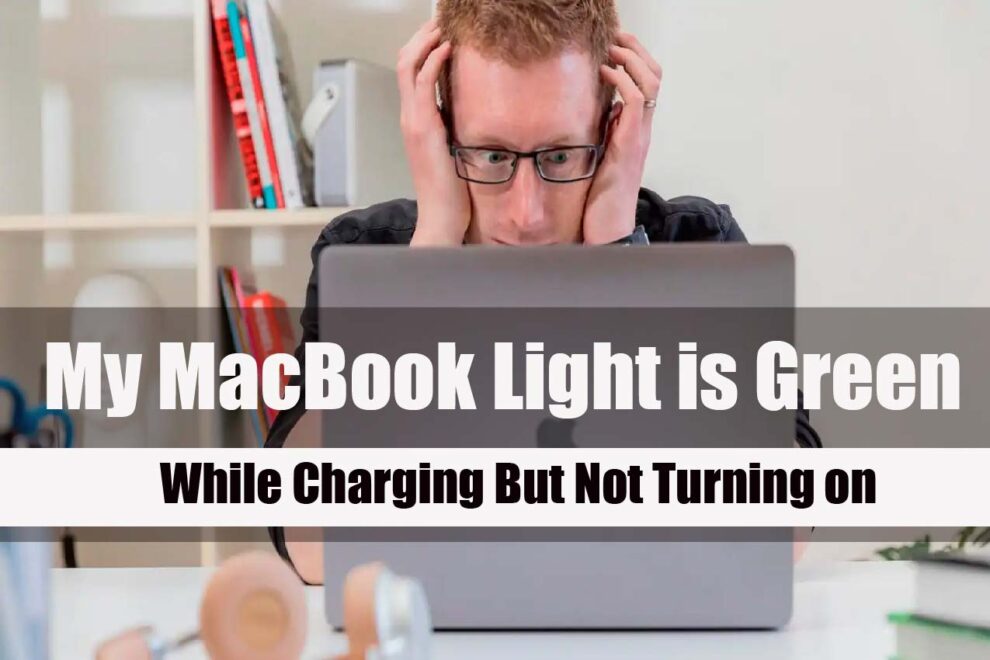Many people are having trouble with their Macbook chargers. When they plug in the cable, the light on the charger should turn green to show that it is charging. However, the light stays green for many people, but their Mac doesn’t turn on or seem to be charging. There are a few troubleshooting steps that you can take to try and fix the issue.
Solution 1: Check for a sufficient power supply.
To check your Mac’s battery life:
- Try unplugging and plugging it back in. If your MacBook has an older MagSafe cable, you will see a green light if it is charging and an amber light if it is not.
- If your Mac has any battery life left, try using an Apple-made cable instead of a third-party one.
- If the outlet is the problem, test it by plugging in another device.
Check your charging cable and adapter, and ensure the jack is fitting correctly and that the cable is not damaged. Also, make sure the adapter is not getting too hot while charging. If the adapter or cable is not the issue, check to see if your MacBook Pro will turn on with a different power adapter.
-Make sure the charging cable fits appropriately in the jack and is tight enough.
-Also, Ensure that the cable is not damaged. A faulty cable can cause issues with charging and damage the port and even the battery in some cases.
-If you are using a different or new power adapter, that might not help. Because there is a higher chance of the problem being the connection rather than with the cable.
-In this case, contact a reliable Apple MacBook repair service center to help you with diagnosing and fixing the issue accurately.
Solution 2: SMC reset.
The SMC (System Management Controller) can often fix specific issues related to battery, power, fan, and some other features. So, try this solution if you can still turn on your MacBook Pro or your Apple notebook appears frozen at the Apple logo. Before performing this, unplug your MacBook’s power adapter.
Reset SMC for non-removable battery
- Completely shut down your MacBook.
- Now, press the “Shift + Option + Control + Power button or Touch ID” together for the next 10 seconds.
- After releasing the keys simultaneously, hit the Mac’sPower button.
That will rest your MacBook’s SMC.
Reset SMC for removable battery
- Completely shut down your Macbook.
- Remove the back cover gently and unplug the device’s battery.
- Press the Power button for about 5 seconds and release it.
- Now, reinsert your Mac’s battery into its proper place.
- Then, switch on your device.
Reset SMC for T2 Security Chip powered Mac.
- Completely shut down your MacBook.
- Press the “Shift + Control + Option + Touch ID or Power button” keys together for the next 7 to 10 seconds.
- After releasing the keys and buttons, hit the Power button and turn on your MacBook.
If you own a MacBook that is M1-powered, ignore this solution, as M1 Macs do not have SMC equipped.
Solution 3: Reboot your MacBook.
If you hear sounds when you press the power button, it might be that your Mac is powered correctly. If you don’t hear any sounds, it might mean that your Mac’s problem is with the software. If your Mac doesn’t boot, it might be something to do with the hardware.
Also, Read – What is Other in MacBook Storage
If your MacBook Pro or MacBook Air won’t turn on, disconnect all keyboards, mice, external HDs, and so on to ensure they are not part of the problem. If there is no change, perform a power cycle.
Solution 4: Perform a Power cycle on your Mac.
If booting your Mac does not work, power cycling the device might help. The power cycle will forcefully restart the system. Follow the steps to perform a power cycle on your Mac:
- Hold the power button to shut down your macOS entirely.
- Remove all the connected power cables and the external peripherals.
- Press the Power button for another 10 seconds, again.
- That will restart the Macbook as it should.
For M1-powered MacBooks, a startup option will be displayed on the screen when pressing the Power button. If so, choose the appropriate option and start up your MacBook.
Solution 5: Perform NVRAM/PRAM reset.
If you are having trouble with your MacBook Pro, resetting the PRAM/NVRAM may help. This is a commonly used solution for fixing minor issues that may prevent the device from starting up. Resetting the PRAM/NVRAM can be done by turning off the device, pressing and holding the power button for a few seconds, and then turning it back on.
For further process, hold the “Cmd + Option (Alt) + P + R” keys simultaneously and turn on your Mac. While the device is starting up, ensure to hold down all the keys. For a better outcome, allow the device to restart twice. You can now release all the keys. Any issue with the PRAM or NVRAM will be fixed by doing this.
Note: The MacBook Pro has a portion of its memory that can be used to store and customize settings. This area is called parameter memory, which is different from the regular memory used by the computer. This means that you can’t reset it, which may be a downside. You can also understand the same as below.
The MacBook Pro does not have a traditional NVRAM but a different type accessed through a terminal command. This allows users to customize settings and view logs. However, the MacBook Pro does not allow users to reset the settings.
Solution 6: Fix the Mac not turning on the issue via Recovery Mode.
If you’re having trouble with your Mac, one solution is to try to fix the issue through Recovery Mode. This is a special mode that your Mac can enter when it’s not working correctly. You can access Recovery Mode by turning on your Mac and pressing Command-R (or using the shortcut command-R on a keyboard). Once you’re in Recovery Mode, you can use Disk Utility to try to fix the issue.
How to bring your Intel-powered Mac to Recovery Mode?
- Completely shut down your MacBook.
- Press and hold the “R + Cmd” keys and start up your Mac.
- You will then see some window pop-ups on the screen.
- Select Disk Utility followed by Continue.
- Pick your relevant Hard Drive and click on the First Aid option.
- Turn off your Mac again when the process is done.
- After some time, turn it on again.
How to bring your M1-powered Mac to Recovery Mode?
- After your MacBook system goes off, hold down the Power button until you notice startup options on the screen.
- Go to Options, then click on the Continue button.
- Choose the user and input the relevant admin details.
- Now, go to the Utility option > click Disk Utility > and hit the Continue button.
- After clicking on the First Aid option, wait until the process is complete.
- Again turn off and turn on your macOS to fix the issue.
Solution 7: Shake your MacBook.
This solution might seem very basic, but it often works. What you should do is:
- Open the lid of the MacBook gently.
- Now, shake your MacBook for a few seconds in slow movements.
- After that, hit the Power button and turn on the device.
Solution 8: Let your MacBook cool down for some time.
Your Mac has been in use for a long time without rest. After removing the charger and shutting down the Mac system, let it cool down. That would also prevent overheating issues. This is how you should adequately let the Mac cool down:
- Remove all the connected items and cables from the Mac device.
- In fact, remove the device’s back case, too.
- Now, allow your Mac to cool down. Since the device is not in charge and in use, let the system cool down for about 2 hours.
- Now, try turning on your Mac again. If the problem persists, connect to the Power Adaptor and try turning it on again. If that works, all is good. But if not, you better contact Apple repair services.
After attempting all the probable solutions, any of them will work to fix the issue. You should also try to reinstall the latest macOS for any software-based issues. But since macOS is such a sensitive system, you should only apply solutions that come your way. If you are unsure, leave the work to the experts instead.
If you find any solution that works for you to fix the MacBook not turning on even when the charging light is a green problem, let us know by leaving a comment here.



















Add Comment